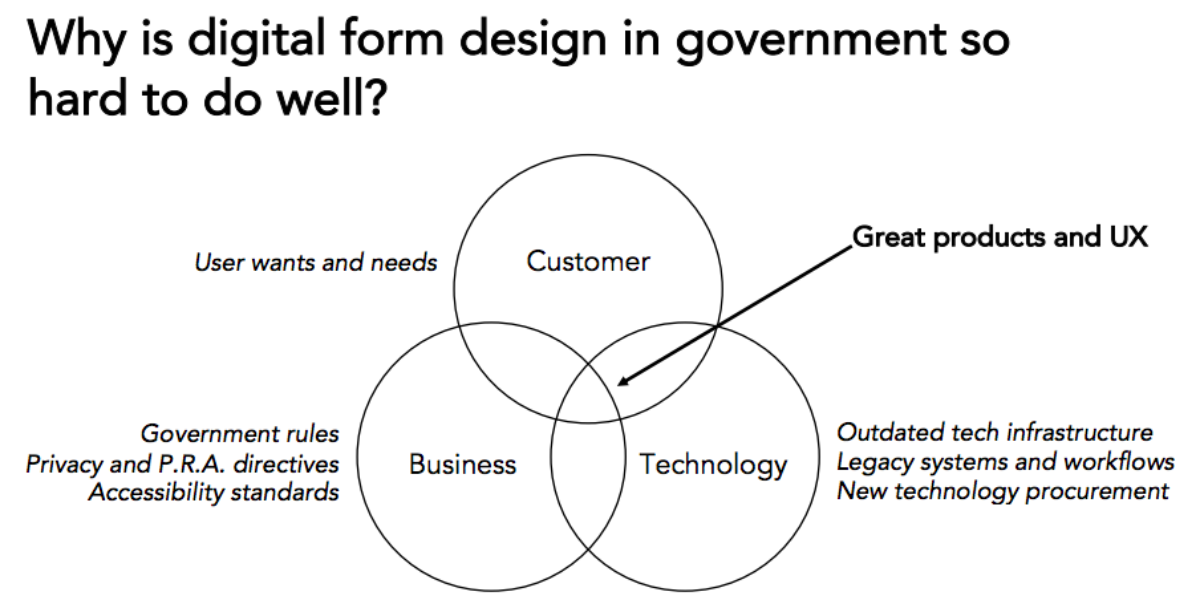- News and Stories
- Blog post
- Summit
Digital Form Design: Opportunities, Challenges, and Cracking the Toughest Problems
Filling out government forms on paper can be a long, tedious, and confusing process. But in the past few years, governments have been finding ways to digitize these processes, much like private sector companies. Digital forms in the civic tech world have helped streamline processes and cut out lengthy paperwork—however, some scenarios are harder to design for than others.
At this year’s Code for America Summit, attendees gained greater insight into this design process, its opportunities, and its challenges in a breakout session on cracking the toughest digital form design problems. This workshop was led by Andy Lewandowski, User Experience Designer at the U.S. Digital Service and Josh Gee, Director of Digital Customer Experience for New York City Transitand former Product Manager for the City of Boston’s Digital Service Delivery Team.
Digital form design: the basics
First and foremost, a well-designed digital form is about great UX. Before we dive into government form design, it’s important to understand digital form design best practices:
- Harness the power of the digital medium
- Create a guided user experience
- Only collect information that’s needed
- Make the user experience error-tolerant
- Be transparent about the adjudication process
- Use plain language
- Size your solution
The essential question is: Why is digital form design so hard to do well in government? While there are many digital experiences that have been optimized, such as TurboTax, other forms are not so easily translated online. There are several factors to take into account when designing a government form, namely user wants and needs, user experience, government rules and regulations, and outdated tech infrastructure.

In other words, just because you can think and dream up a great online form up doesn’t mean it can always be put into action. Regulation blocks might prohibit that form being digitized, or you might find yourself working on outdated infrastructure that doesn’t support your idea.
The bottom line is: If a form is still paper in 2019, there’s usually a reason why.
Reasons that a form still entails a lengthy paper process could have to do with technology, workflow, and/or regulations. There are several factors that often make form design problems tough, in the public or private sector.
- Pain point in the user journey
- Complex business rules
- Onerous information collection
- Bad paper form design
- Paper form-digital form parity requirements
In Andy and Josh’s breakout session, we took a look at some past examples of challenging government design problems, and their solutions.

Design Problem 1:
Scenario: How might we capture occupational history, while being sensitive to periods of under-employment? – From the U.S. citizenship application
Solution: In order to use take into account the various types of work and not shame anyone, the digital team carefully worded the question in the following way:
“Where have you worked and/or attended school (full or part time) during the last 5 years?”
The key takeaway here is to do the work for users to reduce the stigma.
Design Problem 2:
Scenario: How might we collect information about personal trauma in a non-triggering way? – from the Veterans Affairs disability compensation form
Solution: In order to not trigger veterans about their PTSD and other trauma, they used two strategies:
- Slow down information collection
- Offer immediate crisis help
Design problem 3:
Scenario: How might we make it easy for someone to order a death certificate? – From the City of Boston’s death certificate request form.
Solution: Getting to know your users is the single most important thing. The team created a very simple database that pulled up names by simply typing in either the first or last name.
So, what’s the best way to solve for tough digital form design problems?
- Be kind
- Be empathic
- Use your words
- Know that digital can’t solve it all
Ultimately, the challenge of form design comes back to finding ways for government to do what it’s meant to do: to help people, often through difficult situations. Understanding and having empathy for your user in designing forms can go a long way in the creation of processes that achieve that goal. And attendees of Andy and Josh’s breakout session were able to walk away with practical tips on how to—literally—design better government.
Want to learn more? Read Josh’s piece on what he learned in two years of moving government forms online.